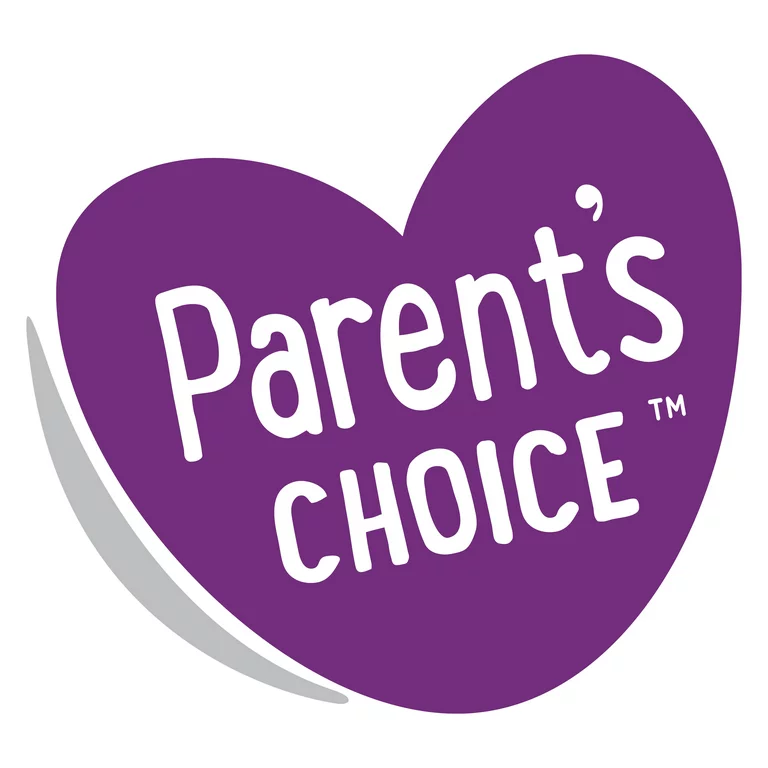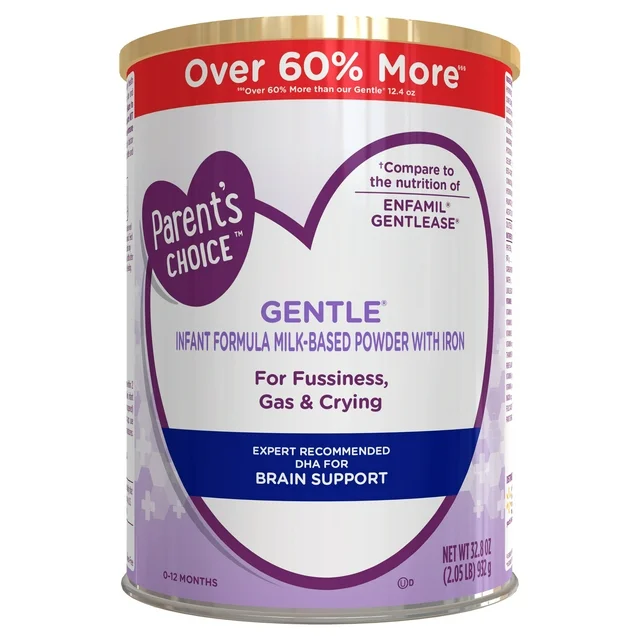
Parent’s Choice Gentle Infant Formula Powder with Iron; for Fussiness, Gas and Crying, 32.8 oz Canister
- Complete Nutrition: This gentle formula provides complete nutrition for baby’s first year; compare to the nutrition of Enfamil Gentlease
- Gentle on Tummies: For fussiness, crying and gas; gentle on tiny, tender tummies; for little ones ages newborn-12 months
- Easy to Digest :This gentle baby formula powder is easy to digest, and each serving supports baby’s growth and development
- Trusted Ingredients for Growth: Expert recommended DHA for brain support; vitamins and minerals help to support immune function; non-GMO ingredients, ingredients not genetically engineered; no artificial growth hormones
- SNAP Eligible: This infant formula can be purchased with Supplemental Nutrition Assistance Program (SNAP) benefits; like all U.S. infant formulas, Gentle Infant Formula meets the same FDA nutritional and quality standards as the national brands
$26.98
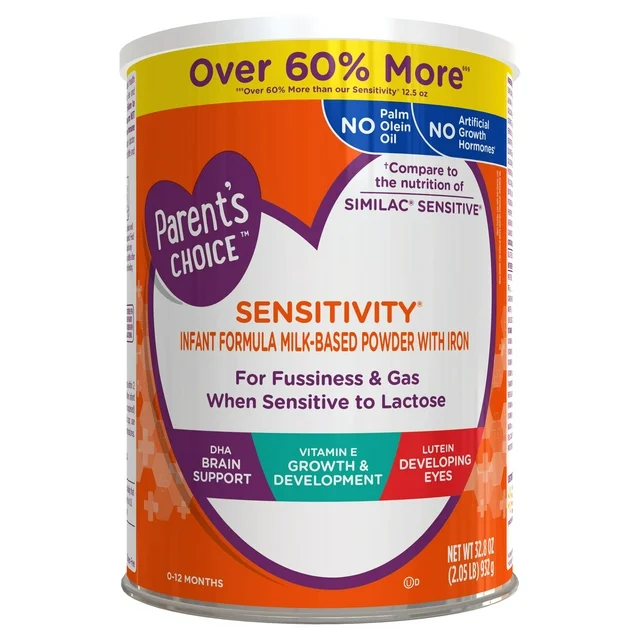
Parent’s Choice Sensitivity Infant Formula Powder with Iron; for Fussiness and Gas, 32.8 oz Canister
- Complete Nutrition: This infant formula provides complete nutrition for baby’s first year; compare to the nutrition of Similac Sensitive
- Lactose Sensitivity: Made specially for fussy, gassy babies, the ingredients in this baby formula support infants who are sensitive to lactose; for little ones ages newborn-12 months
- Easy to Digest: This baby formula is easy to digest, and each serving supports baby’s growth and development
- Trusted Ingredients for Growth: DHA, Lutein and Vitamin E for brain and eye development; non-GMO ingredients, ingredients not genetically engineered; no artificial growth hormones; no Palm Olein Oil
- SNAP Eligible: This infant formula can be purchased with Supplemental Nutrition Assistance Program (SNAP) benefits; like all U.S. infant formulas, Sensitivity Infant Formula meets the same FDA nutritional and quality standards as the national brands
$26.98
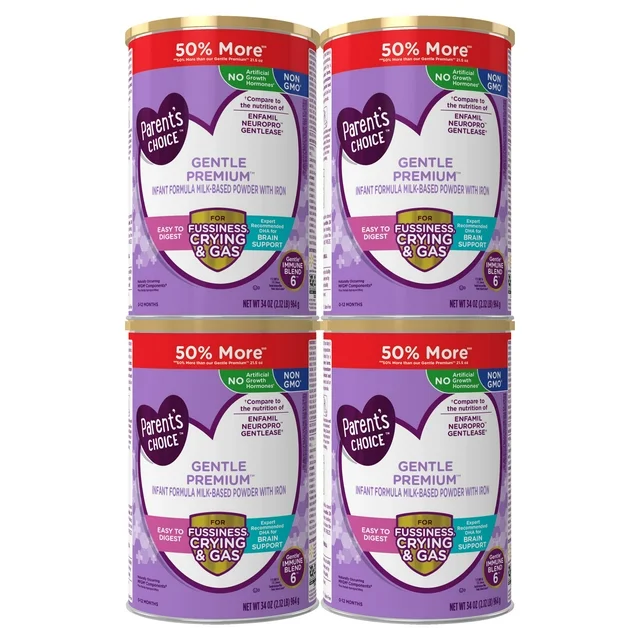
Parent’s Choice Gentle Premium Baby Formula; For Fussiness, Gas and Crying, 34 oz Canister, 4 Pack
- Complete Nutrition: This infant formula provides complete nutrition for baby’s first year; expert recommended DHA for brain support and immune supporting HMOs commonly found in breast milk; compare to the nutrition of Enfamil Neuropro Gentlease
- Gentle on Tummies: For fussiness, gas and crying; gentle on tiny, tender tummies, the ingredients in this baby formula help support growth, immune system health and development; for little ones ages newborn-12 months
- Gentle Immune Blend 6: With 2’-FL HMO, Vitamin C and E, Selenium, Partially Hydrolyzed Whey Protein, Reduced Lactose (has 20 percent the lactose compared to our full lactose, routine, milk-based Infant Premium formula)
- Trusted Ingredients for Growth: DHA to support brain development; non-GMO. No artificial colors, flavors or growth hormones
- SNAP Eligible: This infant formula can be purchased with Supplemental Nutrition Assistance Program (SNAP) benefits. Like all U.S. infant formulas, Gentle Infant Premium meets the same FDA nutritional and quality standards as the national brands.
$129.48
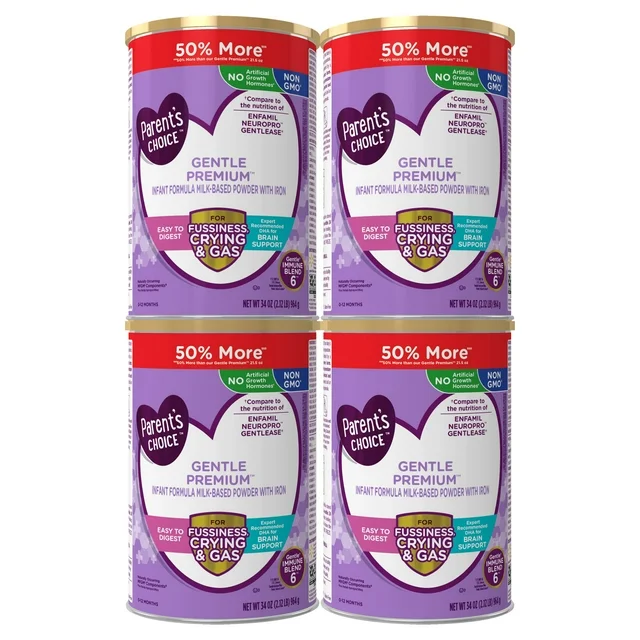
Parent’s Choice Premium Baby Formula Milk-Based Powder, Non-GMO with Iron & DHA, 36 oz Canister
- Complete Nutrition: This infant formula provides complete nutrition for baby’s first year; with expert recommended DHA for brain support and immune supporting HMOs commonly found in breast milk; compare to the nutrition of Enfamil NeuroPro
- Immune Support: For little ones ages newborn-12 months, Parent’s Choice Infant Premium includes Immune Blend 6 with 2’-FL HMO, DHA and ARA, Vitamin C, Vitamin E, Selenium and Zinc; collectively, these support a baby’s immune system
- Inspired by Breast Milk: Naturally occurring MFGM components from whey protein concentrate; milk fat globule membrane composed of proteins and fats
- Trusted Ingredients for Growth: Crafted with ingredients to support your baby’s growth, brain, immunity and general development; non-GMO, ingredients not genetically engineered; no artificial growth hormones or artificial colors or flavors
- SNAP Eligible: This infant formula can be purchased with Supplemental Nutrition Assistance Program (SNAP) benefits; like all U.S. infant formulas, Infant Premium meets the same FDA nutritional and quality standards as the national brands
$35.48
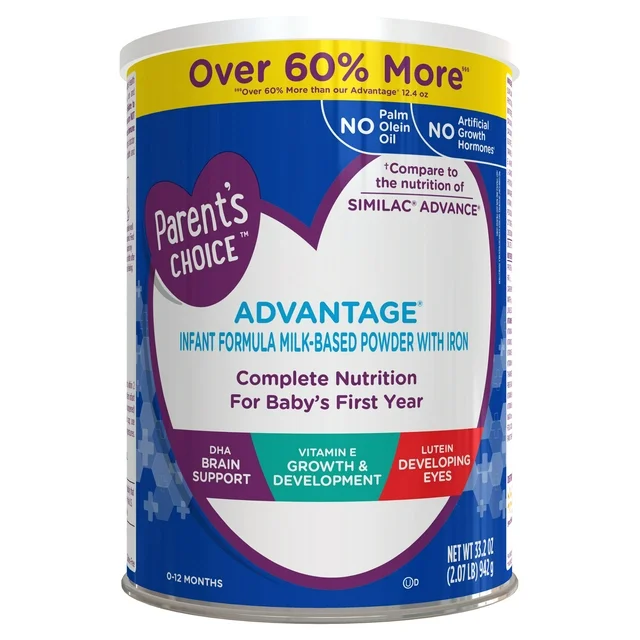
Parent’s Choice Advantage Infant Formula Powder, 33.2 oz Canister
- Complete Nutrition: Parent’s Choice Advantage Infant Formula provides complete nutrition for baby’s first year; compare to the nutrition of Similac Advance
- Supports Brain and Eye Development: DHA for brain support; Lutein for eye support; for little ones ages newborn-12 months
- Easy to Digest: This easy to digest formula is inspired by breast milk; it contains essential nutrients support baby’s growth and development
- Trusted Ingredients for Growth: Non-GMO ingredients, ingredients not genetically engineered; no artificial growth hormones; no Palm Olein Oil
- SNAP Eligible: This infant formula can be purchased with Supplemental Nutrition Assistance Program (SNAP) benefits; like all U.S. infant formulas, Advantage Infant Formula meets the same FDA nutritional and quality standards as the national brands
$26.98
A Mom’s Honest Journey Through Formula Feeding Options That Won’t Break the Bank
When I found myself standing in the baby aisle at 2 AM, bleary-eyed and comparing formula cans like my life depended on it (because, well, my baby’s did), I wished someone had handed me a straightforward guide about Parent’s Choice formula. Three kids later, I’ve become that someone for other parents. Let me walk you through everything you need to know about this wallet-friendly option that’s been a lifesaver for my family.
My Formula Journey Begins
I never expected to become a formula feeding expert. With my first baby, Ellie, I had visions of exclusive breastfeeding for at least a year. But life had other plans when my milk supply couldn’t keep up with her appetite. Enter formula—and the overwhelming decision of which one to choose.
The most important thing I’ve learned about infant formula is that fed is best, and Parent’s Choice offers quality nutrition at a price that doesn’t require a second mortgage. That revelation changed everything for our family.
What Exactly Is Parent’s Choice Formula?
Parent’s Choice is Walmart’s store-brand infant formula. Initially, I was skeptical—aren’t store brands just watered-down versions of the premium stuff? Absolutely not, as it turns out.
Parent’s Choice formulas are manufactured by Perrigo, which produces many store-brand formulas in FDA-inspected facilities. The formula meets the same strict FDA nutritional standards as the big-name brands, containing the essential nutrients babies need for healthy development.
What surprised me most was learning that Perrigo makes formulas for multiple store brands, not just Walmart. The difference? Primarily the label and the price tag.
Safety First: Can Newborns Have Parent’s Choice?
When my second child arrived, I was better prepared and had already researched formula options extensively. Many new parents wonder: Is Parent’s Choice formula safe for newborns?
The answer is yes. Parent’s Choice offers infant formulas specifically designed for newborns that meet the same FDA nutritional requirements as premium brands. Their Premium Infant Formula is suitable from birth through the first 12 months.
However, always consult your pediatrician before starting any formula, especially with newborns. When I introduced formula to my youngest at two weeks old, our pediatrician reviewed the ingredients and gave us the green light.
The Comparison Game: Parent’s Choice vs. Premium Brands
Let’s talk about the elephant in the room—how does Parent’s Choice really compare to brands like Similac and Enfamil that cost nearly twice as much?
When my second baby was about three months old, I created a spreadsheet comparing nutritional profiles (yes, I’m that mom). The revelation? The nutritional content was remarkably similar. Parent’s Choice formulas are designed to be nutritionally comparable to their brand-name counterparts:
- Parent’s Choice Premium (blue) → Similar to Enfamil Infant
- Parent’s Choice Gentle (yellow) → Similar to Similac Pro-Sensitive
- Parent’s Choice Sensitivity (orange) → Similar to Similac Pro-Total Comfort
- Parent’s Choice Advantage (purple) → Similar to Similac Pro-Advance
The primary differences were minor variations in:
- The specific blend of prebiotics
- Source of DHA (both have it, just from different sources)
- Some carbohydrate ratios
But in terms of the critical nutrients babies need to thrive? Virtually identical.
Finding Parent’s Choice Formula: Availability Matters
The good news is that finding Parent’s Choice formula is straightforward—it’s available at Walmart stores nationwide and on Walmart.com. The catch? It’s exclusively a Walmart brand, so you won’t find it at Target, Kroger, or Amazon.
During the formula shortage of 2022, I learned to check Walmart’s online inventory before making the trip. The website usually shows current stock at nearby stores, saving unnecessary trips when supplies are limited.
If you prefer shopping online, Walmart offers subscription options that can save you the hassle of remembering to reorder. I set up a monthly subscription for our household, which has been a brain-space saver during the chaos of raising three kids under five.
Breaking Down the Ingredients
When my mother-in-law questioned my choice of formula (don’t they always?), I pulled up the ingredient list to show her exactly what was in it.
Parent’s Choice formulas typically contain:
- A protein base (usually nonfat milk or whey protein concentrate)
- Carbohydrates (lactose or corn syrup solids, depending on the variant)
- Vegetable oils (palm, soy, coconut, high oleic sunflower, or safflower)
- Essential vitamins and minerals
- DHA and ARA for brain and eye development
- Prebiotics to support digestive health
The Sensitive and Gentle versions have partially hydrolyzed proteins (pre-broken down) to be easier to digest. The Sensitivity version is also lactose-reduced for babies who struggle with lactose.
What impressed me was the absence of unnecessary additives. No artificial growth hormones, no artificial flavors or colors. Just the nutrition babies need.
The Sensitive Stomach Situation
When my second baby developed fussiness after feedings, our pediatrician suggested trying a formula for sensitive tummies. Parent’s Choice offers two options:
- Parent’s Choice Gentle (yellow container): Contains partially hydrolyzed proteins and reduced lactose, similar to Similac Pro-Sensitive or Gerber Good Start Gentle.
- Parent’s Choice Sensitivity (orange container): Features partially hydrolyzed proteins and even less lactose, comparable to Similac Pro-Total Comfort.
We tried the Gentle formula first, and within three days, the post-feeding fussiness had significantly improved. Had that not worked, we would have moved to the Sensitivity version.
What made this trial period less stressful was knowing I wasn’t spending $35+ per can on an experiment. At roughly half the price of name brands, testing different formulas became financially feasible.
Colic Concerns: Can Parent’s Choice Help?
Colic is that mysterious condition that makes otherwise healthy babies cry for hours on end. With my first child, we experienced those tear-filled evenings, and switching formulas was one of many strategies we tried.
Parent’s Choice doesn’t specifically label any formula as “anti-colic,” but their Gentle and Sensitivity options can help babies with digestive discomfort that might contribute to colic symptoms. The partially hydrolyzed proteins in these formulas are broken down to be easier to digest.
For severe colic cases, Parent’s Choice doesn’t offer a specialized formula equivalent to Similac Alimentum or Nutramigen. If your baby requires a hypoallergenic formula, you might need to look at prescription options through your pediatrician.
In our case, the Gentle formula, combined with upright feeding positions and proper burping techniques, made evenings more peaceful—though not perfect. No formula is a magical cure for colic, but finding one that agrees with your baby’s digestive system can certainly help.
Proper Preparation: Getting It Right Every Time
Preparing formula correctly is crucial for your baby’s safety and nutrition. When I started using Parent’s Choice, I followed these steps religiously:
- Wash hands thoroughly before handling formula or bottles
- Use clean bottles and nipples (sterilize them for newborns)
- Boil water for 1 minute and let cool to around 158°F (70°C) for powdered formula
- Measure water first, then add the exact amount of powder (using the scoop provided)
- Cap the bottle and shake gently until powder dissolves completely
- Cool to body temperature before feeding
Parent’s Choice formula uses the standard mixing ratio of 1 scoop (unpacked) to 2 ounces of water. Each container includes a scoop, and it’s important to use that specific scoop for accurate measurements.
One tip I discovered: prepare a day’s worth of bottles and refrigerate them to save time during those hectic newborn days. Just warm them as needed under running warm water.
The Organic Question
Here’s where Parent’s Choice has a gap in their lineup—they don’t currently offer an organic formula option. For parents prioritizing organic ingredients, this is a limitation.
When my sister-in-law wanted an organic option for her baby, she had to look at other brands like Earth’s Best, Happy Baby, or Bobbie. These typically come with a higher price tag than even premium non-organic formulas.
The good news is that all infant formulas, organic or not, must meet the same FDA nutritional standards. The difference is primarily in how the ingredients are sourced and processed.
Cost Comparison: The Budget-Friendly Reality
Let’s talk dollars and cents, because this is where Parent’s Choice truly shines.
As of my last purchase, Parent’s Choice formula costs approximately $0.49 per ounce, while premium brands like Similac and Enfamil range from $1.00 to $1.30 per ounce. That’s a savings of 50-60% for nutritionally comparable formula.
For perspective, here’s what that meant for our family:
- Premium formula: ~$200-250 per month
- Parent’s Choice: ~$100-125 per month
Over a year, switching to Parent’s Choice saved us approximately $1,200-1,500. That’s a family vacation, a significant chunk of a college fund, or a lot of diapers!
For families on WIC, it’s worth noting that Parent’s Choice is often covered, though specific options vary by state. Check with your local WIC office for details.
Age Appropriateness: From Birth to Toddlerhood
Parent’s Choice offers formulas for different stages of development:
- Infant Formula (birth to 12 months): Provides complete nutrition for your baby’s first year.
- Advantage Formula (birth to 12 months): Their premium option with additional prebiotics for digestive health.
- Toddler Formula (12-36 months): Designed for toddlers transitioning from infant formula or breast milk to regular milk.
Unlike some premium brands, Parent’s Choice doesn’t offer specialized formulas for specific age brackets within the first year (like a 0-3 month formula versus a 6-12 month formula). Their infant formulas are designed to meet nutritional needs throughout the entire first year.
With my children, I used the standard infant formula from birth until their first birthday, then transitioned directly to whole milk as recommended by our pediatrician. For parents preferring a transition formula, the Toddler option provides additional nutrients that may be lacking in a toddler’s sometimes picky diet.
Lactose Intolerance Solutions
When my nephew showed signs of lactose intolerance (gas, fussiness, diarrhea after feeds), my sister turned to Parent’s Choice Sensitivity formula as an affordable option.
Parent’s Choice offers two options for babies with potential lactose issues:
- Parent’s Choice Gentle (yellow): Reduced lactose content
- Parent’s Choice Sensitivity (orange): Even less lactose
Neither is completely lactose-free, however. For babies with confirmed lactose intolerance rather than just sensitivity, a specialized lactose-free formula might be necessary.
It’s important to note that true lactose intolerance in infants is relatively rare. Most babies with digestive issues have sensitivities rather than complete intolerances, which is why partially hydrolyzed, reduced-lactose formulas often work well.
What Other Parents Are Saying: Reviews and Experiences
Reading reviews became my midnight hobby during feeding challenges. Parent’s Choice formulas generally receive positive reviews, with most parents citing two primary benefits:
- Cost savings without nutritional compromise
- Similarity to premium brands their babies previously used
Common praises include:
- “My baby transitioned from Enfamil to Parent’s Choice without noticing any difference.”
- “The Gentle formula was a game-changer for my fussy baby.”
- “We were able to afford formula without stretching it or cutting other necessities.”
Common criticisms involve:
- Some babies experience more gas (though this happens with all formula brands)
- Occasional complaints about mixing difficulty (forming more clumps than some premium brands)
- Limited specialized options for babies with severe allergies or medical conditions
In my local moms’ group, about half the formula-feeding mothers use Parent’s Choice, and most report experiences similar to premium brands at a fraction of the cost.
Shelf Life and Storage: Practical Considerations
Formula expiration dates matter. Parent’s Choice powder formula typically has a shelf life of 12-18 months unopened, while ready-to-feed variants last 6-12 months.
Once opened:
- Powder formula: Use within 30 days
- Ready-to-feed: Use within 48 hours if refrigerated
- Prepared bottles: Use within 24 hours if refrigerated, 1 hour at room temperature
I learned to check the container’s bottom for the expiration date before purchasing. During the formula shortage, some stores relaxed rotation policies, leaving older stock on shelves.
For storage, keep unopened formula in a cool, dry place—not the refrigerator, which can introduce moisture. After opening, ensure the lid is tightly closed and store in a cool, dry cabinet.
Allergen Information: What Parents Need to Know
When my friend’s baby developed a milk protein allergy, she needed to understand formula ingredients thoroughly.
Parent’s Choice standard formulas contain:
- Milk proteins (casein and whey)
- Soy ingredients (oil, lecithin)
They don’t contain:
- Gluten
- Peanuts
- Tree nuts
- Eggs
- Fish
For babies with milk protein allergies, Parent’s Choice doesn’t offer a hypoallergenic option (like Nutramigen or Alimentum). These specialized formulas use extensively hydrolyzed or amino acid-based proteins that bypass most allergic responses.
If your baby shows allergy symptoms (excessive spit-up, rash, blood in stool, extreme fussiness), consult your pediatrician immediately. You may need to switch to a specialized hypoallergenic formula.
Nutritional Support: What’s Inside the Can
The nutritional profile of Parent’s Choice formula is impressive. All their formulas provide:
- DHA and ARA for brain and eye development
- Choline for cognitive function
- Iron for healthy blood cells
- Essential vitamins and minerals
- Proper protein, fat, and carbohydrate ratios
Their Premium/Advantage formula also includes a prebiotic blend to support digestive health and immune function.
When comparing nutrition labels with my mom friends, we found the differences between Parent’s Choice and premium brands were minimal—different forms of the same nutrients rather than missing components.
Just like premium formulas, Parent’s Choice meets or exceeds FDA requirements for all essential nutrients babies need in their first year.
Safety Record: Recalls and Quality Control
Safety is paramount when it comes to baby formula. Parent’s Choice formulas are manufactured in FDA-inspected facilities with strict quality control standards.
Has Parent’s Choice had recalls? Yes, but so have all major formula brands. The most significant was a 2019 recall of a limited batch of Advantage formula due to potential metal contamination. Walmart handled this transparently, notifying customers and removing affected products.
To ensure safety, I always:
- Check the formula container for damage before purchasing
- Verify that the safety seal is intact
- Register purchased formula on the Walmart website to receive recall notifications
- Keep track of lot numbers until the container is empty
It’s worth noting that the major 2022 formula shortage primarily affected Abbott (Similac) products, not Parent’s Choice, which remained relatively available in most regions.
Making the Switch: Transitioning Tips
When I switched my second baby from a premium brand to Parent’s Choice, I followed this gradual transition plan:
Day 1-2: 75% current formula, 25% Parent’s Choice
Day 3-4: 50% current formula, 50% Parent’s Choice
Day 5-6: 25% current formula, 75% Parent’s Choice
Day 7+: 100% Parent’s Choice
This gradual approach minimizes digestive upset that can come with sudden formula changes. Some babies are more sensitive to changes than others—my first needed this slow transition, while my second happily accepted new formula without any mixing.
Signs your baby is adjusting well include:
- Normal bowel movements (though some change in color/consistency is expected)
- Typical feeding patterns
- Standard sleep habits
- General contentment
If your baby shows signs of discomfort with the new formula after a full week, consult your pediatrician.
Growth and Weight Gain
A common concern I had when switching to Parent’s Choice was whether it would support proper weight gain. Our pediatrician assured us that as long as the formula meets FDA nutritional standards (which Parent’s Choice does), it provides the calories and nutrients needed for appropriate growth.
All Parent’s Choice formulas provide approximately 20 calories per ounce when prepared according to directions, identical to premium brands. The standard infant formula contains:
- 1.8g protein per 100 calories
- 5.3g fat per 100 calories
- 10.9g carbohydrates per 100 calories
At checkups, all three of my children maintained their growth curves while on Parent’s Choice formula, and our pediatrician was completely satisfied with their development.
Parent’s Choice Formula Lineup: Finding Your Match
Parent’s Choice offers several formula options to meet different needs:
- Parent’s Choice Premium Infant Formula (blue): Standard infant formula, comparable to Enfamil Infant or Similac Pro-Advance.
- Parent’s Choice Advantage (purple): Enhanced with additional prebiotics, similar to Similac Pro-Advance.
- Parent’s Choice Gentle (yellow): Partially hydrolyzed proteins and reduced lactose for babies with mild digestive sensitivity, comparable to Similac Pro-Sensitive.
- Parent’s Choice Sensitivity (orange): More extensively broken-down proteins and even less lactose, similar to Similac Pro-Total Comfort.
- Parent’s Choice Soy (green): Plant-based protein for babies with milk protein sensitivity or families choosing a vegetarian option.
- Parent’s Choice Added Rice Starch (tan): Contains rice starch to help thicken the formula in the stomach, potentially helping babies with reflux.
- Parent’s Choice Toddler Formula (red): Designed for children 12-36 months, with nutrients that might be missing in a toddler’s diet.
They also offer both powder and ready-to-feed options for some varieties, though the ready-to-feed selection is more limited and significantly more expensive per ounce.
My Personal Experience: Three Kids Later
Through three babies and countless formula cans, Parent’s Choice has been a reliable part of our feeding journey. What started as a budget necessity became a confident choice for our family.
When my third baby arrived and we immediately supplemented with formula, I didn’t even bother with premium brands. We started directly with Parent’s Choice Gentle, and he thrived from day one.
The money we saved allowed us to redirect funds to other baby needs—and occasionally, self-care for exhausted parents. That $1,500 annual savings meant we could afford the nicer car seat, build a more substantial college fund, and occasionally order takeout when cooking felt impossible.
Final Thoughts: Making the Best Choice for Your Family
The single most important factor in choosing formula is finding one that nourishes your baby while fitting into your family’s overall needs. Parent’s Choice offers scientifically formulated nutrition at a price point that alleviates financial stress for many families.
Is it identical to premium brands? Not 100%—there are minor differences in specific ingredient sources and manufacturing processes. But does it provide complete nutrition that helps babies thrive? Absolutely.
I’ve watched three very different babies grow healthy and strong on Parent’s Choice formula. I’ve calculated thousands in savings over our parenting journey. And I’ve experienced the relief of knowing I’m providing quality nutrition without financial strain.
Ultimately, fed is best. Whether you choose Parent’s Choice or another formula, what matters is that your baby receives the nutrition they need in a way that works for your family. For us, Parent’s Choice has been that solution—quality without compromise, nutrition without excessive cost.
Whatever you choose, know that you’re doing great, parent. These feeding decisions are just one of many you’ll make, and your baby will thrive with your love and care regardless of which formula can sits on your counter.
